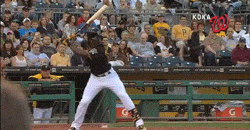Baseball Hitting Video Spine Mistake PART 3
In This Baseball Hitting Video Spine Mistake,
We’re going over:
- The One-Joint Rule (how-to test “Spinal Integrity”, also known as head and spine alignment),
- Spine Engine Theory (how ALL athletic movement is driven), and
- Tensegrity, OR Tension Integrity (discover how explosive the body’s own natural springiness can be).
Here’s a video of Physical Therapist Dr. Kelly Starrett of MobilityWOD.com demonstrating the One-Joint Rule:
In case you missed it, in the above video, Dr. Kelly Starrett said:
“Hinging at one of the segments [vertebraes in the neck]…when we put a hinge across the central nervous system, the body recognizes that as a primary insult, or threat to the body, because you’re basically guillotining or kinking the nervous system. You’ve kinked ‘the tube’, so it [force production] just drops off.”
He also mentioned:
“The spine has major potential to decrease your force production.”
Here’s video of 2013 NL MVP Andrew McCutchen breaking his head and spine alignment. This is actually a semi-common hitting power mistake made by quite a few of my young hitters – as you’ll see in a bit. Scary to think that Andrew McCutchen was bleeding force at impact with the numbers he put up this past year:
The first baseball hitting video spine mistake was leaked from The Truth About Explosive Rotational Power online video course. This is all a part of the human movement rules. As you can see, breaking our spinal integrity at contact can have a bleeding force effect on performance.
- Fix Late Swings Fast: 2025 Pitch Recognition & See-Decide-Swing Training for Youth Baseball Power Hitters - October 6, 2025
- Safe Youth Weighted Bat Training: Proven Overload/Underload Drills to Increase Exit Velocity in Games Starting Tonight - September 29, 2025
- AI Coaching Course 2025: Youth Baseball & Softball Practice Plan + Off-Season & In-Season Workout Builder Fast - September 23, 2025












Hey Joey,
Sorry, I just ran across a few of your videos on YouTube, and I haven’t watched them in any particular order, so I’m probably missing something. Although, I find some of the things you are talking about very interesting, I’m having a difficult time understanding this particular concept as it applies to hitting. -Not that I necessarily disagree with it, but I just have a lot of questions. You talk about what you shouldn’t be doing as it applied to Andrew McCutchen having his chin to his chest at contact – not being a good thing. Yet, in another video with two other Major Leaguers, you talk about them having their noses to the ball – being a good thing. It looks like their chins are to their chest, and if they aren’t completely to their chest, at least they have “kinked the hose.” What I didn’t see you demonstrate or show an example of, was a major leaguer or any other hitter demonstrating how the head SHOULD BE at the point of contact. It seems awfully difficult to not tilt your head someway at contact, whether straight down or sideways.???
As far as Dr. Kelly Starrett, I’m probably going to fall into your trap so you can say, “Ah, ha. You fool! That’s precisely the point I’m trying to make.” Anyway. – Again, I’m not sure how this applies to hitting.- Head straight. – Muscles tight and strong. Head bent. – Muscles loose and weak. Aren’t tight muscles slow muscles. I can’t imagine a hitter trying to swing with such tense muscles. Dr. Starrett even uses the word “stiff” to describe the muscles when the head is straight. How is this good for hitting? Wouldn’t the looser muscles fall into your elasticity of the body theory being a good thing?
I don’t know. Much confusion spins around in my brain. Set me straight. – Un-kink my hose.
I realize you posted this sometime ago, and maybe you have already answered these types of questions. I apologize if that is the case.
Thanks,
Noel
Hey Noel, I appreciate the comment and I’ll do my best to clear this up. Remember, just because these guys are Major Leaguers doesn’t mean they do it perfect, when under scrutiny of proven movement science. Kelly Starrett refers to two differences in flexion/extension of the spine: 1) Local and 2) Global. Local (bad) would be bending at more than one vertebra, say the neck (chin to chest). In this case, the brain turns Local and Global muscles on to protect the joint in peril. Tighter muscles are slower muscles. Global (good) would be flexing the spine and head as one unit (head stays in line with the spine). The brain has to recruit less muscle use because it doesn’t sense any danger to the body. A loose body is a fast body. To transfer energy efficiently at contact, a hitter MUST practice Global Flexion (side bending) towards the plate. Head stays in line with spine. Plase note, the head can turn from side to side without an instability effect. Chin starts over front shoulder and ends somewhere around the back shoulder (depends on where contact is with the pitch). I mentioned Mike Trout (I think) keeps his “nose behinds the barrel”. A hitter can do this without Local Flexion in the neck. Try it for yourself. Also, I recommend doing the One-Joint Rule test to show how much strength we lose when bending locally at the neck.
Wow! Thanks for getting back to me so quickly. This is starting to make more sense. If you might have a link or links to videos of players doing this the correct way, it would probably help me better understand it if I can see it visually in action. It doesn’t have to be an analysis. – It could just be look at Miggy in this video or Josh Hamilton in this video, etc. Thanks Joey!
For sure Noel…check out this YouTube video of Miggy – https://www.youtube.com/watch?v=1fFJVFPXmV8 & this one of Mike Trout – https://www.youtube.com/watch?v=lX_dm39fkfw. You don’t see a tremendous amount local flexion in the neck. It’s mostly global flexion in the head and spine. Even though some of the guys you may look at – like Bryce Harper (local lateral) – do local flexing at the neck, doesn’t mean they’re being as efficient as humanly possible.
Awesome! Got it. Thanks.
You got it!